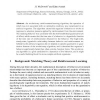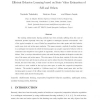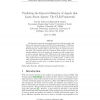246 search results - page 9 / 50 » Learning behavior styles with inverse reinforcement learning |
FLAIRS
2000
13 years 9 months ago
2000
A robotic agent must coordinate its coupled concurrent behaviors to produce a coherent response to stimuli. Reinforcement learning has been used extensively in coordinating sensin...
ECAL
2005
Springer
14 years 1 months ago
2005
Springer
An evolutionary reinforcement-learning algorithm, the operation of which was not associated with an optimality condition, was instantiated in an artificial organism. The algorithm ...
IJAIT
2008
13 years 7 months ago
2008
ion mechanism to create a representation of space consisting of the circular order of detected landmarks and the relative position of walls towards the agent's moving directio...
AR
2008
13 years 7 months ago
2008
The existing reinforcement learning methods have been seriously suffering from the curse of dimension problem especially when they are applied to multiagent dynamic environments. ...
CORR
2000
Springer
13 years 7 months ago
2000
Springer
We describe a framework and equations used to model and predict the behavior of multi-agent systems (MASs) with learning agents. A difference equation is used for calculating the ...



